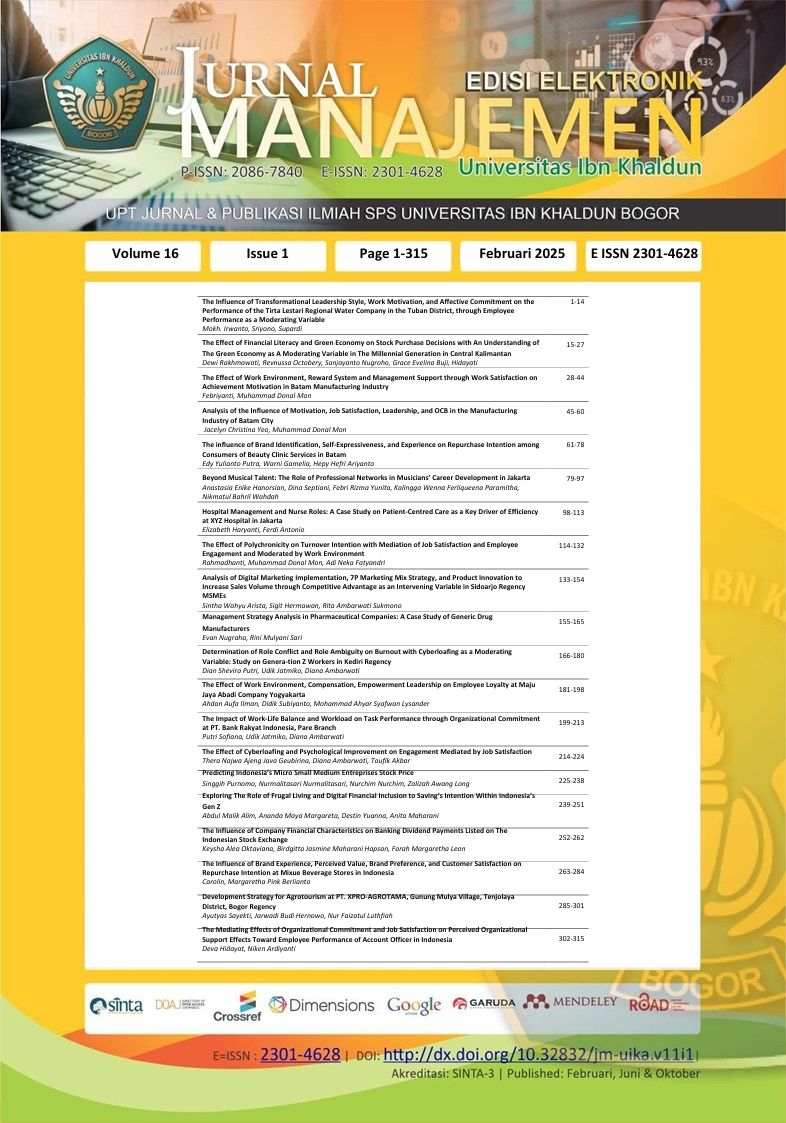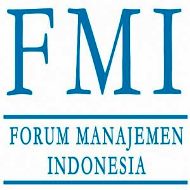Management Strategy Analysis in Pharmaceutical Companies
A Case Study of Generic Drug Manufacturers
DOI:
https://doi.org/10.32832/jm-uika.v16i1.16740Kata Kunci:
Strategy Management, SWOT, IFE-EFE, Internal-Exsternal, QSPMAbstrak
MEA is the establishment of a free market in Southeast Asia with the goal of attracting international investment. Several factors contribute to Indonesia's ability to win AEC competition, including a big potential market and the possibility to become an exporting economy, particularly in the pharmaceutical business. However, numerous obstacles must be considered, according to government objectives, for the current situation of the Indonesian pharmaceutical sector to improve. The Indonesian pharmaceutical market has a lot of promise, but approximately 95% of medicinal raw materials will be imported. Becouse of that to attempted to analyze the aforementioned destination for strategy management using many methods, including SWOT, IFE and EFE, internal-external, and QSPM matrix. The gap in ratings, based on the data analysis results, indicates that the company's internal procedures need to be addressed. Internal improvement is a continual approach to the concept of continuous improvement that is used to carry out the strategy. Based on the above description, study on pharmaceutical firms is required to determine what techniques to enhance management systems may support smooth operations. This research was conducted at a pharmaceutical company that produces generic drug.
Referensi
Ahsan, T., Mirza, S. S., Gull, A. A., & Majeed, M. A. (2023). How to deal with customer and supplier concentration to attain sustainable financial growth? The role of business strategy. Business Strategy and the Environment, February, 4600–4619. https://doi.org/10.1002/bse.3383
Andersen, T. J., & Torp, S. (2019). Achieving Adaptive Responsiveness through Strategic Planning, Autonomous Strategic Actions, and Interactive Controls. In T. J. Andersen, S. Torp, & S. Linder (Eds.), Strategic Responsiveness and Adaptive Organizations: New Research Frontiers in International Strategic Management (pp. 61–80). Emerald Publishing Limited. https://doi.org/10.1108/978-1-78973-011-120191005
Asmussen, C. G., & Foss, N. J. (2022). Strategizing and economizing in global strategy. Global Strategy Journal, 12(3), 578–591. https://doi.org/10.1002/gsj.1443
Augier, M., & Dew, N. (2018). A Behavioral (Simonian) Perspective on (Behavioral) Strategic Management Research. In Behavioral Strategy in Perspective (Vol. 39, pp. 51–67). Emerald Publishing Limited. https://doi.org/10.1108/S0742-332220180000039004
Beamish, P. W., & Hasse, V. C. (2022). The importance of rare events and other outliers in global strategy research. Global Strategy Journal, 12(4), 697–713. https://doi.org/10.1002/gsj.1437
Bellucci, C., Lavarda, R. A. B., & Floriani, D. E. (2023). Open strategizing and accelerated internationalization process in different contexts. Journal of Strategy and Management, 16(2), 189–210. https://doi.org/10.1108/JSMA-10-2021-0207
Benito, G. R. G., Cuervo-Cazurra, A., Mudambi, R., Pedersen, T., & Tallman, S. (2022). The future of global strategy. Global Strategy Journal, 12(3), 421–450. https://doi.org/10.1002/gsj.1464Bhuiyan, F., Rana, T., Baird, K., & Munir, R. (2023). Strategic outcome of competitive advantage from corporate sustainability practices: Institutional theory perspective from an emerging economy. Business Strategy and the Environment, December 2022, 4217–4243. https://doi.org/10.1002/bse.3362
BPS. (2021). Arah Perubahan Badan Pusat Statistik 2021-2024. 1–125.
BPS Indonesia. (2020). Catalog : 1101001. Statistik Indonesia 2020, 1101001, 790.
Buckley, P. J. (2022). Navigating three vectors of power: Global strategy in a world of intense competition, aggressive nation states, and antagonistic civil society. Global Strategy Journal, 12(3), 543–554. https://doi.org/10.1002/gsj.1444
Ceruti, M., Williams, A., & Bedford, D. (2019a). Defining Roles and Responsibilities to Manage the Strategy. In Translating Knowledge Management Visions into Strategies (pp. 163–172). Emerald Publishing Limited. https://doi.org/10.1108/978-1-78973-763-920191013
Ceruti, M., Williams, A., & Bedford, D. (2019b). Knowledge Management Strategies – The Big Picture. In Translating Knowledge Management Visions into Strategies (pp. 97–115). Emerald Publishing Limited. https://doi.org/10.1108/978-1-78973-763-920191008
Ceruti, M., Williams, A., & Bedford, D. (2019c). Realizing the Vision – Moving from Strategy to Tactics. In Translating Knowledge Management Visions into Strategies (pp. 151–162). Emerald Publishing Limited. https://doi.org/10.1108/978-1-78973-763-920191012
Cobb, H. R., & Brummel, B. J. (2023). Work–Nonwork Policies and Practices: The Strategic Opportunity to Consider Organizational Boundary Management Strategies. In P. D. Harms & C.-H. (Daisy) Chang (Eds.), Stress and Well-being at the Strategic Level (Vol. 21, pp. 45–64). Emerald Publishing Limited. https://doi.org/10.1108/S1479-355520230000021003
Corrigendum to: Global strategy collections: Emerging market multinational enterprises (Global Strategy Journal, (2022), 12, 2, (199-208), 10.1002/gsj.1439). (2023). Global Strategy Journal, 13(1), 248. https://doi.org/10.1002/gsj.1453
David, F. R. (2011). Strategic Management: Concepts and Cases. Prentice Hall.
De Angelis, R., Morgan, R., & De Luca, L. M. (2023). Open strategy and dynamic capabilities: A framework for circular economy business models research. Business Strategy and the Environment, February, 4861–4873. https://doi.org/10.1002/bse.3397
DeBerge, T. (2023). Responsibility boundaries and the governance of global value chains: The interplay of efficiency, ethical, and institutional pressures in global strategy. Global Strategy Journal, October, 1–27. https://doi.org/10.1002/gsj.1498
Eom, Y., & Woo, M. (2023). Comparison of the trading strategies and market impact costs of the National Pension Service’s internal and external management. Journal of Derivatives and Quantitative Studies, 31(3), 197–218. https://doi.org/10.1108/JDQS-12-2022-0027
Heizer, J., Render, B., & Munson, C. (2016). Operations Management: Sustainability and Supply Chain Management. Pearson Education.
Holopainen, M., Saunila, M., & Ukko, J. (2023). Facilitating performance measurement and management through digital business strategy. Measuring Business Excellence, 27(2), 246–260. https://doi.org/10.1108/MBE-01-2022-0015
Khalifa, A. S. (2021). Strategy and what it means to be strategic: redefining strategic, operational, and tactical decisions. Journal of Strategy and Management, 14(4), 381–396. https://doi.org/10.1108/JSMA-12-2020-0357
Kwofie, T. E., Ellis, F. A., Addy, M. N., Amos-Abanyie, S., Aigbavboa, C., & Afram, S. O. (2023). Relationship clusters and performance of conflict management strategies in cross-organisational projects teams. International Journal of Productivity and Performance Management, ahead-of-p(ahead-of-print). https://doi.org/10.1108/IJPPM-09-2021-0504
Lamberg, J. A., Ojala, J., & Gustafsson, J. P. (2022). Strategy and business history rejoined: How and why strategic management concepts took over business history. Business History, 64(6), 1011–1039. https://doi.org/10.1080/00076791.2020.1856076
Lampraki, A., Kolympiris, C., Grohsjean, T., & Dahlander, L. (2023). The new needs friends: Simmelian strangers and the selection of novelty. Strategic Management Journal, November 2022, 1–29. https://doi.org/10.1002/smj.3564
Lê, J. K., & Schmid, T. (2019). An Integrative Review of Qualitative Strategy Research: Presenting 12 “Designs-in-Use.” In Standing on the Shoulders of Giants (Vol. 11, pp. 115–154). Emerald Publishing Limited. https://doi.org/10.1108/S1479-838720190000011009
Leiblein, M. J., Reuer, J. J., Larsen, M. M., & Pedersen, T. (2022). When are global decisions strategic? Global Strategy Journal, 12(4), 714–737. https://doi.org/10.1002/gsj.1451
Lima Rua, O., Musiello-Neto, F., & Arias-Oliva, M. (2023). Linking open innovation and competitive advantage: the roles of corporate risk management and organisational strategy. Baltic Journal of Management, 18(1), 104–121. https://doi.org/10.1108/BJM-08-2021-0309
Masoumik, S. M., & Abdul-Rashid, S. H. (2021). The Role of Green Strategy Adoption in Driving Green Supply Chain Management Practices. In T. J. Andersen (Ed.), Strategic Responses for a Sustainable Future: New Research in International Management (pp. 21–48). Emerald Publishing Limited. https://doi.org/10.1108/978-1-80071-929-320214002
Mignon, I., & Bankel, A. (2023). Sustainable business models and innovation strategies to realize them: A review of 87 empirical cases. Business Strategy and the Environment, 32(4), 1357–1372. https://doi.org/10.1002/bse.3192
Oliveira, C., Martins, A., Camilleri, M. A., & Jayantilal, S. (2021). Using the Balanced Scorecard for Strategic Communication and Performance Management. In M. A. Camilleri (Ed.), Strategic Corporate Communication in the Digital Age (pp. 73–88). Emerald Publishing Limited. https://doi.org/10.1108/978-1-80071-264-520211005
Pedersen, T., & Tallman, S. (2023). Global strategy collections: Multinationality and performance. Global Strategy Journal, 13(2), 517–531. https://doi.org/10.1002/gsj.1478
Peljhan, D., Miloš Sprčić, D., & Marc, M. (2018). Strategy and Organizational Performance: The Role of Risk Management System Development. In M. J. Epstein, F. H. M. Verbeeten, & S. K. Widener (Eds.), Performance Measurement and Management Control: The Relevance of Performance Measurement and Management Control Research (Vol. 33, pp. 65–91). Emerald Publishing Limited. https://doi.org/10.1108/S1479-351220180000033004
Phung, G., Trinh, H. H., Nguyen, T. H., & Trinh, V. Q. (2023). Top-management compensation and environmental innovation strategy. Business Strategy and the Environment, 32(4), 1634–1649. https://doi.org/10.1002/bse.3209
Reshad, A. I., Biswas, T., Agarwal, R., Paul, S. K., & Azeem, A. (2023). Evaluating barriers and strategies to sustainable supply chain risk management in the context of an emerging economy. Business Strategy and the Environment, December 2022, 4315–4334. https://doi.org/10.1002/bse.3367
Teece, D. J. (2022). A wider-aperture lens for global strategic management: The multinational enterprise in a bifurcated global economy. Global Strategy Journal, 12(3), 488–519. https://doi.org/10.1002/gsj.1462
Tjahjadi, B., Soewarno, N., Karima, T. El, & Sutarsa, A. A. P. (2023a). Business strategy, spiritual capital and environmental sustainability performance: mediating role of environmental management process. Business Process Management Journal, 29(1), 77–99. https://doi.org/10.1108/BPMJ-11-2021-0718
Tjahjadi, B., Soewarno, N., Karima, T. El, & Sutarsa, A. A. P. (2023b). Socially friendly business strategy and social sustainability performance: roles of spiritual capital and social management process. Social Responsibility Journal, ahead-of-p(ahead-of-print). https://doi.org/10.1108/SRJ-11-2022-0496
Todorov, K., & Akbar, Y. H. (2018). Basics of Strategic ManagementEtihad Rail: A New Way to Change a Business Landmark in the United Arab EmiratesCase Study: Inchcape plc. Part 3. In Strategic Management in Emerging Markets (pp. 109–161). Emerald Publishing Limited. https://doi.org/10.1108/978-1-78743-355-720181003
Wijethilake, C., & Ekanayake, A. (2018). Proactive Strategic Responses to Corporate Sustainability Pressures: A Sustainability Control System Framework. In M. A. Malina (Ed.), Advances in Management Accounting (Vol. 30, pp. 129–173). Emerald Publishing Limited. https://doi.org/10.1108/S1474-787120180000030006
Yamini, S., Fousiani, K., & Wisse, B. (2023). Self-construal, face concerns and conflict management strategies: a meta-analysis. Cross Cultural & Strategic Management, 30(2), 375–412. https://doi.org/10.1108/CCSM-07-2021-0130
Yin, R. K. (2018). Case Study Research and Design. Sage Publications, 352.
Unduhan
Diterbitkan
Cara Mengutip
Terbitan
Bagian
Lisensi
Hak Cipta (c) 2024 Jurnal Manajemen

Artikel ini berlisensi Creative Commons Attribution-NonCommercial 4.0 International License.
Authors who publish with this journal agree to the following terms:
- Authors retain copyright and grant the journal right of first publication with the work simultaneously licensed under a Creative Commons Attribution-NonCommercial-ShareAlike 4.0 International License that allows others to share the work with an acknowledgement of the work's authorship and initial publication in this journal.
- Authors can enter into separate, additional contractual arrangements for the non-exclusive distribution of the journal's published version of the work (e.g., post it to an institutional repository or publish it in a book), with an acknowledgement of its initial publication in this journal.
- Authors are permitted and encouraged to post their work online (e.g., in institutional repositories or on their website) prior to and during the submission process, as it can lead to productive exchanges, as well as earlier and greater citation of published work (See The Effect of Open Access).











